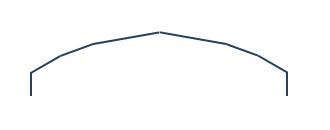I've learned a lot from stuff posted online about how to create hoop houses. Probably the most useful document to date is "A Small Backyard Greenhouse for the Home Gardener" from the North Carolina Cooperative Extension. The instructions give you a 14-foot long greenhouse that is 12 feet wide and 6 feet high.
But I don't have space for a full-up hoop house. I've been messing around with powerpoint, trying to figure out how to fit a 300 gallon tank and six 50-gallon grow beds into an 8-foot wide space in the minimum length. I think I've got it:
I'll talk about the aquaponics layout later. For now it is sufficient to say that I should be able to fit everything in a 8 foot wide by 14 foot long footprint.
Instead of PVC pipe, I'll be constructing the body of my greenhouse out of 1/2" Electric Metallic Tube (EMT) conduit. Conduit is pretty inexpensive, running just over $2 for a 10' length. It's stronger than PVC, and I can bend it to the shape shown above.
In fact, I've figured out the "recipe." Conduit benders can be had for ~$30, and are marked for bends of standard size (10, 22.5, 30, 45, and 60 degrees). If you've not used a conduit bender before, know that the "center" of even a shallow bend will be 1-2 inches offset from the 'start' of the bend. Many benders will have a mark that shows the location of "the exact center of a 45 degree bend." No matter what angle you bend, the center will be pretty close to that 45 degree center mark, so position your tubing accordingly.
- Mark the pipe in the middle (5') and make marks 8", 21", and 34" from either end.
- Bend the pipe 22.5 degrees at the 5' mark. [From this point on it is useful to get a partner who can hold the pipe so the rest of the bends are in the same plane.]
- Move the conduit bender to the 8" mark and make a 60 degree bend.
- Move the conduit bender to the 21" mark and make a 10 degree bend.
- Move the conduit bender to the 34" mark and make another 10 degree bend.
- Flip the pipe and bend the other side (60 degrees at 8", 10 degrees at both 21" and 34")
This shape minimizes height delta between the edge and center of the structure, provides strength along the roof "faces," and gives a peak at the center to help shed snow. For a 14-foot long greenhouse with frames every 2 feet, you'll be making 8 of these "tops." If they don't lay flat, you can do some "correction" with the conduit bender.
Next, create 16 EMT "legs" by cutting 10-foot lengths in half with a pipe cutter or hack saw. These legs will be connected to the tops using EMT set-screw couplings. Position the set screws so they face the inside of the frame, so they won't snag the plastic sheeting you'll be draping over your structure.
From this point you can pretty much follow the instructions for the North Carolina hoop house from the top of this post. But instead of a wide, short semi-circle, your greenhouse will be only 8 feet wide and about 7 feet high. Also, you will be installing a simple door in each of the two end walls, so you can access the beds on either side of the fish tank.
Two last points - I plan to screw three 14-foot lengths of EMT to the frames with EMT 2-hole straps and zinc sheet metal screws. These will serve as a ridge pole and lateral stiffeners. Also, since part of the location where I'm putting this is brick patio, I plan to connect the greenhouse to a support under the fish tank. I figure 300 gallons of water (2,400 pounds!) is enough to keep the house from "shifting."



I ended up getting tapped to write The Complete Idiot's Guide to Aquaponic Gardening for Penguin Book Group. The book is now available for purchase at Amazon.com. It includes lots of DIY plans as well as everything I wished I could have found in a book back when I was starting out (which wasn't very long ago...). So far the reviews are good! And there are plans for a greenhouse in there as well!
ReplyDelete